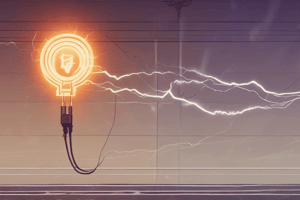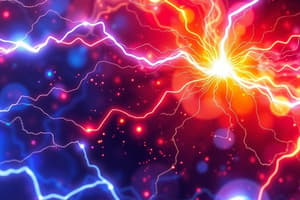Podcast
Questions and Answers
What is described as the force that motivates charge carriers to move in a circuit?
What is described as the force that motivates charge carriers to move in a circuit?
- Current
- Voltage (correct)
- Resistance
- Power
Which quantity is a measure of opposition to current flow in an electric circuit?
Which quantity is a measure of opposition to current flow in an electric circuit?
- Voltage
- Conductance
- Resistance (correct)
- Current
How is voltage best described in relation to a circuit?
How is voltage best described in relation to a circuit?
- The measure of potential energy between two points (correct)
- The speed of charge flow
- The amount of resistance a circuit can handle
- The total charge in the circuit
What is the relationship described by Ohm's Law?
What is the relationship described by Ohm's Law?
Which of the following measurements is typically not associated with electrical circuits?
Which of the following measurements is typically not associated with electrical circuits?
Which of the following statements about resistance is true?
Which of the following statements about resistance is true?
In what way are voltage and resistance commonly expressed?
In what way are voltage and resistance commonly expressed?
Which of the following best represents charge flow in an electric circuit?
Which of the following best represents charge flow in an electric circuit?
What is the symbol for electric charge quantity?
What is the symbol for electric charge quantity?
What does the letter 'I' represent in electrical terms?
What does the letter 'I' represent in electrical terms?
How is 1 volt defined in relation to joules and coulombs?
How is 1 volt defined in relation to joules and coulombs?
What does Ohm's Law describe about the relationship between voltage, current, and resistance?
What does Ohm's Law describe about the relationship between voltage, current, and resistance?
Which of the following is true about direct current (DC) measurements?
Which of the following is true about direct current (DC) measurements?
What is the abbreviation for the unit of measurement for current flow?
What is the abbreviation for the unit of measurement for current flow?
Which Greek letter is used to represent electrical resistance?
Which Greek letter is used to represent electrical resistance?
What happens to the current if the voltage increases while resistance remains constant, according to Ohm's Law?
What happens to the current if the voltage increases while resistance remains constant, according to Ohm's Law?
What do the symbols 'E' and 'V' typically represent in electrical measurements?
What do the symbols 'E' and 'V' typically represent in electrical measurements?
What is a coulomb a measure of?
What is a coulomb a measure of?
How can Ohm's Law be represented visually to solve for different quantities?
How can Ohm's Law be represented visually to solve for different quantities?
What does the letter 'R' represent in electrical measurements?
What does the letter 'R' represent in electrical measurements?
What is the equivalence of 1 ampere in terms of coulombs?
What is the equivalence of 1 ampere in terms of coulombs?
What is a key factor to remember when calculating instantaneous electrical values?
What is a key factor to remember when calculating instantaneous electrical values?
Flashcards
Resistance
Resistance
The opposition to the flow of electric charge in a circuit.
Electric Current
Electric Current
The continuous movement of electric charge through a circuit.
Voltage
Voltage
The force that motivates electric charge to flow in a circuit.
Ohm's Law
Ohm's Law
Signup and view all the flashcards
Ampere (A)
Ampere (A)
Signup and view all the flashcards
Volt (V)
Volt (V)
Signup and view all the flashcards
Ohm (Ω)
Ohm (Ω)
Signup and view all the flashcards
Electric Circuit
Electric Circuit
Signup and view all the flashcards
What is the symbol for resistance in electrical circuits?
What is the symbol for resistance in electrical circuits?
Signup and view all the flashcards
What is the unit of electrical current named after?
What is the unit of electrical current named after?
Signup and view all the flashcards
What is the unit of electrical potential difference named after?
What is the unit of electrical potential difference named after?
Signup and view all the flashcards
What is the unit of electrical resistance named after?
What is the unit of electrical resistance named after?
Signup and view all the flashcards
What does the symbol "I" represent in electrical equations?
What does the symbol "I" represent in electrical equations?
Signup and view all the flashcards
What does the symbol "E" represent in electrical equations?
What does the symbol "E" represent in electrical equations?
Signup and view all the flashcards
What is a coulomb?
What is a coulomb?
Signup and view all the flashcards
What is electrical current?
What is electrical current?
Signup and view all the flashcards
What is electrical potential difference?
What is electrical potential difference?
Signup and view all the flashcards
What is a joule?
What is a joule?
Signup and view all the flashcards
What is 1 volt equal to?
What is 1 volt equal to?
Signup and view all the flashcards
What is Ohm's Law?
What is Ohm's Law?
Signup and view all the flashcards
According to Ohm's Law, how can voltage be calculated?
According to Ohm's Law, how can voltage be calculated?
Signup and view all the flashcards
According to Ohm's Law, how can resistance be calculated?
According to Ohm's Law, how can resistance be calculated?
Signup and view all the flashcards
According to Ohm's Law, how can current be calculated?
According to Ohm's Law, how can current be calculated?
Signup and view all the flashcards
Study Notes
Ohm's Law
- Ohm's Law describes the relationship between current, voltage, and resistance.
- Discovered by Georg Simon Ohm, published in 1827.
- Electric current is the continuous movement of electric charge in a conductive path.
- Voltage is the force motivating charge movement, measured between two points.
- Resistance is the opposition to current flow, also measured between two points.
- Current depends on voltage and resistance.
Measurement Units
- Current (I): Unit is the ampere (A), named after André-Marie Ampère.
- Voltage (E or V): Unit is the volt (V), named after Alessandro Volta.
- Resistance (R): Unit is the ohm (Ω), named after Georg Simon Ohm.
Equation
- Ohm's Law equation: E = I * R
- E represents voltage
- I represents current
- R represents resistance
Variations of Ohm's Law
- I = E / R
- R = E / I
Symbols and Units
- Electric Charge (Q): Unit is the coulomb (C). 1 coulomb = 6.25 x 1018 electrons.
- The amp (unit for current) is equal to 1 coulomb of charge passing by a given point in a circuit in one second.
- Current is the rate of electric charge motion through a conductor.
- Voltage is the measure of potential energy per unit charge.
- 1 volt = 1 joule of potential energy per coulomb of charge.
Additional Notes
- Lowercase letters (e, i) represent instantaneous values (at a given moment), while upper-case letters (E, I) represent steady/stable values.
- Voltage and resistance are relative quantities between two points in a circuit.
- Ohm's Law states that current is directly proportional to voltage for a given temperature within a metal conductor.
- There are two variations of Ohm's Law (using algebra), for determining I and R.
Simple Circuit Example
- In a circuit with one voltage source (e.g., battery) and one resistance (e.g., lamp), Ohm's Law can easily calculate any unknown variables (voltage, current, resistance).
Remembering Ohm's Law
- A triangle can help remember how to solve for any unknown value, given the other two.
Studying That Suits You
Use AI to generate personalized quizzes and flashcards to suit your learning preferences.




